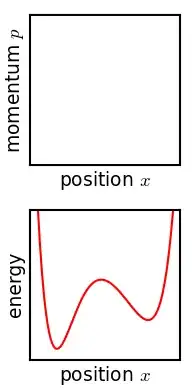Mixing is a very physically intuitive concept: a set of particles saitsfying a small spread of uncertainty in their initial conditions, follow paths that enter (nearly) into (nearly) any region, and in a relatively "uniform" way: After sufficiently long a period of time, the percentage of them found within in that region, even within a short period, is proportional to the volume of the region.
Consider the following intuitive example. We consider a (small) amount of uncertainty in the initial conditions, which means we consider not a point but a small volume to begin with. Picture it as being a bit of black colour in the phase space, where the rest of the phase space is white. Now suppose the dynamics really is mixing: somebody is stirring the phase space as if it were a can of paint (into which we put this bit of colour). If the dynamics is truly "mixing", then after a while, the colour will be, as far as the eye can tell, more or less evenly spread throughout the phase space. This is the intuitive example of "mixing" dynamics. Another way of putting this is, even a small deviation in the initial condition eventually results in a large deviation in the state.
Ergodicity is more of a mathematical notion than a physical notion. It means that the time averages are (nearly always) equal to the phase averages. This is the "dual" to the above notion. The ergodic theorem says that this holds as long as the phase space cannot be decomposed into two disjoint invariant subsets of positive measure ("metric transitivity") . Well, you could be generous and say that this is physical too.
A trivial example of ergodic dynamics is irrational rotation on the torus. consider the two-dimensional surface of a three-dimenional doughnut. Or, what is the same, consider the unit square with its edges identified, so a particle that reaches the boundary immediately re-appears at the opposite edge. The dynamics is simple unaccelerated free motion. The initial condition consists of the initial position plus a velocity vector. If the slope of the velocity vector is rational number, the particle will eventually return to its original position and the motion is not ergodic since there are regions it will never reach. But such initial conditions constitute a set of measure zero. "Nearly all" initial conditions have a velocity vector with irrational slope. On such trajectories, the time average of an observable equals the phase average. So this dynamical system is ergodic.
